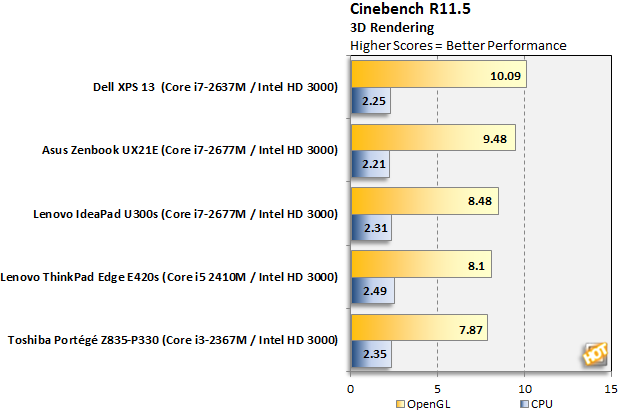Maxon's Cinebench R11.5 benchmark is based on the company's Cinema 4D software used for 3D content creation and tests both the CPU and GPU in separate benchmark runs. On the CPU side, Cinebench renders a photorealistic 3D scene by tapping into up to 64 processing threads (CPU) to process more than 300,000 total polygons, while the GPU benchmark measures graphics performance by manipulating nearly 1 million polygons and huge amounts of textures.
 |
| Cinebench R11.5 64-bit |
| 3D Rendering Performance On the CPU |
|

Cinebench is almost exclusively CPU- and GPU-dependent in terms of the way systems have to render workloads. Memory bandwidth can also affect the GPU test somewhat as well, but it's no where near as sensitive to things like disk throughput, like PCMark. The results here are even more surprising. As you can see, even with identical CPUs at play (in the case of the Asus Zenbook and Lenovo U300s), system performance can vary somewhat. Lenovo's machine actually has single channel DDR3 memory on board, with half the memory bandwidth, which adversely affects the GPU score for Lenovo here.
However, the Dell XPS 13 is similarly configured like the Asus Zenbook, with dual channel memory but a slightly slower CPU technically (max Turbo Boost of 2.8GHz for the Core i7-2637M vs. 2.9GHz for the Core i7-2677M in the Zenbook). Some time has passed since we tested the Asus machine, so it's possible that Intel driver maturity could be affecting the GPU test somewhat but we're more inclined to think that Dell's thermal solution in the XPS 13 is allowing the CPU to Turbo up longer, or at least Dell has things dialed in that way. This would explain their slight edge in this benchmark test. The other possibility is that background tasks that each machine comes configured with for power management etc, could be affecting scores as well. Again, we disable virus scanning software for testing but anything that loads on boot-up from the factory is left intact.
 |
| Far Cry 2 3D Game Test |
| DX10 Light Duty Gaming Performance |
|
|

FarCry 2
|
Like the original, FarCry 2 is one of the more visually impressive games to be released on the PC to date. Courtesy of the Dunia game engine developed by Ubisoft, FarCry 2's game-play is enhanced by advanced environment physics, destructible terrain, high resolution textures, complex shaders, realistic dynamic lighting, and motion-captured animations. We benchmarked the test systems in this article with the FarCry 2 benchmark tool using one of the built-in demo runs recorded in the "Ranch" map. |

Dell's XPS 13 is consistently the fastest ultrabook we've tested to date again, by just a hair's-width. Though obviously, you'd have to dial resolution down another notch to get playable frame rates in this title. Considering this is an ultralight notebook, not designed in any way as a gaming machine, this comes as no surprise.
 |
| Left 4 Dead 2 Game Testing |
| DX9 Light Duty Gaming Performance |
|
Left 4 Dead 2, though it has reasonably good visuals, is a bit easier on the graphics subsystem. This was a game engine that the Asus UX21 Zenbook could handle a bit better as well, though we didn't have it available in the lab for re-testing. Let's see how Dell's XPS 13 ultrabook fairs versus Lenovo's recent ultrabook release.

Here the XPS 13 maintains playable frame rates all the way up through the native resolution of its display (1366X768). Dell's new ultrabook also shows a consistent 10% advantage over the Lenovo machine.









